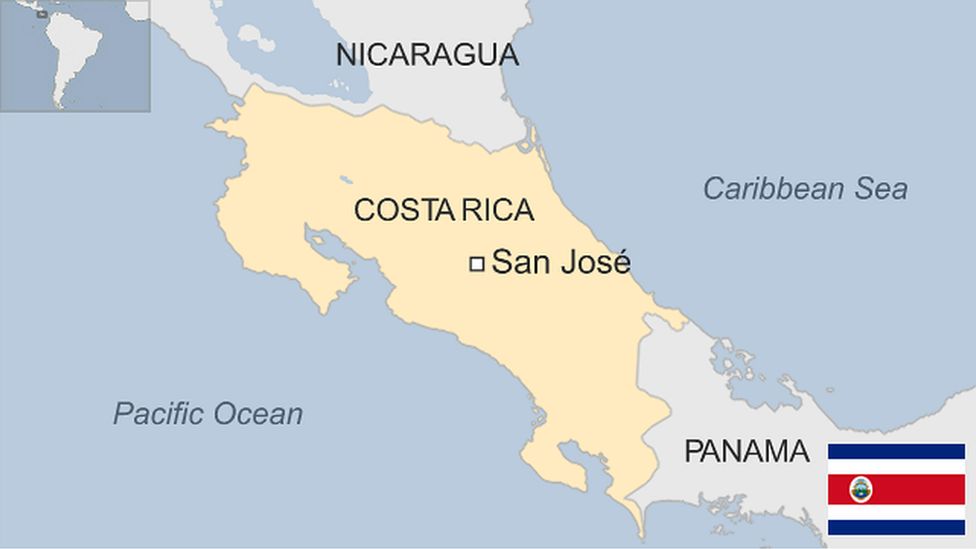Costa Rica country profile
- Published

Costa Rica has coastlines on the Pacific Ocean and the Caribbean.
One of the most stable countries in the region, it is also the only Central American state without a permanent standing army, after it was abolished in 1948.
It also enjoys one of the highest standards of living in the region, although a significant percentage of Costa Ricans still live below the poverty line.
Its rich biodiversity makes Costa Rice a popular destination for eco-tourists, and tourism in general is the top source of income.
- Read more country profiles - Profiles by BBC Monitoring
REPUBLIC OF COSTA RICA: FACTS
- Capital: San José
- Area: 51,100 sq km
- Population: 5.2 million
- Languages: Spanish, also Mekatelyu, Bribri, Jamaican Creole
- Life expectancy: 77 years (men) 82 years (women)
LEADER
President: Rodrigo Chaves
Economist Rodrigo Chaves won the presidential election in April 2022, beating former President José María Figueres.
The 60-year-old ran on a promise of shaking up traditional party politics, and tapped into discontent with Costa Rica's struggling economy.
MEDIA
Costa Rica has a lively press and broadcasting scene. It also has the best record of respecting freedom of expression in Latin America, says Reporters Without Borders.
TIMELINE
Key dates in Costa Rica's history:
1502 - Christopher Columbus visits the area, naming it Costa Rica, (Rich Coast), but disease and resistance by the local population delay the establishment of a permanent settlement for 60 years.
A lack of gold and silver makes Costa Rica into a poor and sparsely-inhabited region within the Spanish empire.
1808 - Coffee is introduced into Costa Rica from Cuba and soon becomes the principal crop, its dominance lasting well into the 20th Century.
1821 - Costa Rica declares independence from Spain and joins the Mexican Empire.
1823 - Costa Rica becomes a province of the Central American Federation along with El Salvador, Guatemala, Honduras and Nicaragua.
1838 - Costa Rica becomes a fully independent country.
1849-59 - Costa Rica takes the lead in organising Central American resistance against William Walker, the US adventurer who took over Nicaragua in 1855.
1874 - US businessman Minor Cooper Keith introduces banana cultivation and starts the United Fruit Company.
1948 - Former president Rafael Angel Calderon loses the election by a slim margin and refuses to accept the result; more than 2,000 people are killed in the ensuing 44-day civil war.
1948-49 - A new constitution is adopted, which includes the dissolution of the armed forces.
1985 - US-trained anti-guerrilla force begins operating following clashes with Sandinista troops from Nicaragua.
1987 - President Oscar Arias Sanchez wins the Nobel Peace Prize for his role in ending civil wars in El Salvador and Nicaragua. He wins a second term in 2006.
2000 - Costa Rica and Nicaragua resolve long-standing dispute over navigation along San Juan river, which serves as their border.
2007 - Switches diplomatic allegiance from Taiwan to China in a bid to attract Chinese investment.
2009 - Costa Rica says it is to re-establish ties with Cuba, 48 years after they were broken off in 1961.
2010 - Laura Chinchilla becomes Costa Rica's first female president.
2011 - International Court of Justice orders Nicaragua and Costa Rica to keep troops back from a disputed river border.
2015 - Costa Rica wins a long-standing territorial row with Nicaragua after International Court of Justice rules it has sovereignty over a small patch of wetlands known as Isla Portillo on the San Juan river.
Related Topics
- Published13 February
- Published31 March 2023
- Published4 April 2023
- Published4 April 2023
- Published14 February 2023